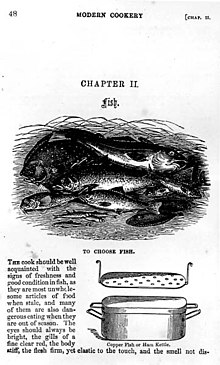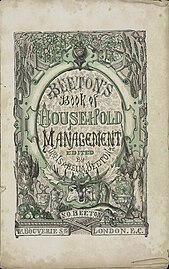Recipe
[5] The large collection of recipes De re coquinaria, conventionally titled Apicius, appeared in the 4th or 5th century and is the only complete surviving cookbook from the classical world.[8] Recipe books from the Qajar era are numerous, the most notable being Khorak-ha-ye Irani by prince Nader Mirza.Many of these manuscripts give very good information and record the re-discovery of many herbs and spices including coriander, parsley, basil and rosemary, many of which had been brought back from the Crusades.[13] With the advent of the printing press in the 16th and 17th centuries, numerous books were written on managing households and preparing food.Although eclipsed in fame and regard by Isabella Beeton, the first modern cookery writer and compiler of recipes for the home was Eliza Acton.Her pioneering cookbook, Modern Cookery for Private Families published in 1845, was aimed at the domestic reader rather than the professional cook or chef.This was a guide to running a Victorian household, with advice on fashion, child care, animal husbandry, poisons, the management of servants, science, religion, and industrialism.[26] Sometimes the sub-recipe calls for the ingredient to be held for several hours, overnight, or longer, which home cooks sometimes find frustrating as it means the main recipe cannot be made in a single session or day.[26][27][28] Sub-recipes discovered late and calling for an ingredient the cook does not have on hand means a special shopping trip or trying to find a substitute.[39] Television networks such as the Food Network and magazines are still a major source of recipe information, with international cooks and chefs such as Jamie Oliver, Gordon Ramsay, Nigella Lawson and Rachael Ray having prime-time shows and backing them up with Internet websites giving the details of all their recipes.






Semiconductor fabricationingredientsingredientcuneiformAkkadianBabyloniaancient EgyptianhieroglyphsMithaecusAthenaeusDeipnosophistaeCato the ElderDe Agri CulturaApiciusal-Warraqal-BaghdadiPersianSafavidsQajar eraForme of Curyin EnglandaristocracyEarly Modern PeriodcorianderrosemaryCrusadesNimatnama-i-Nasiruddin-ShahiMedieval Indiansamosasprinting pressIsabella BeetonEliza ActonBrussels sproutsDelia SmithFredrika RunebergRunebergsbakelseMrs Beeton's Book of Household ManagementVictorianchild careanimal husbandrypoisonsservantsFannie FarmerconfitspicklespreserveschutneyscondimentsChristina TosiVegetable KingdomPhilip HarbenJames BeardCEEFAXUsenet newsgrouplate-2000s recessioncoronavirus pandemicFood NetworkJamie OliverGordon RamsayNigella LawsonRachael RayTop ChefIron ChefCookbookCourse (food)Culinary arthRecipemicroformatList of dessertsList of foodsRhyming recipeAncient Egyptian cuisineAndrew DalbyMerriam WebsterWayback MachineThe Washington PostAustin ChronicleNew York TimesFolkloreAnimal taleFairy taleLegendTall talesParablePersonal narrativeUrban legendOral traditionFolk etymologyNursery rhymeProverbRiddleSayingWord gameFolk beliefBirthstoneFolk religionFolk saintGhostloreLegend trippingLuminous gemstonesMythologyOld wives' taleRitualSilver bulletWeather loreFolk artsFolk artFolk costumeFolk epicFolk danceFolk instrumentFolk musicFolk playFolk poetryFolk wrestlingFoodwaysCunning folkFakeloreFolk devilFolk healerFolk heroFolklore studiesMorphology (folkloristics)Aarne–Thompson–Uther IndexMotif-Index of Folk-LiteratureStorytelling